2008 CHEVROLET AVEO child seat
[x] Cancel search: child seatPage 72 of 384
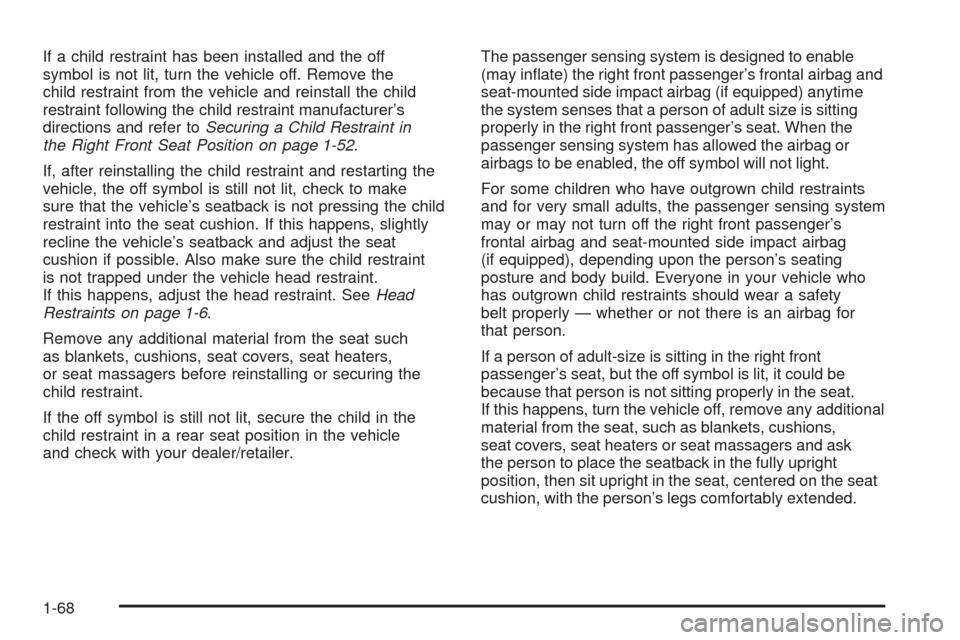
If a child restraint has been installed and the off
symbol is not lit, turn the vehicle off. Remove the
child restraint from the vehicle and reinstall the child
restraint following the child restraint manufacturer’s
directions and refer toSecuring a Child Restraint in
the Right Front Seat Position on page 1-52.
If, after reinstalling the child restraint and restarting the
vehicle, the off symbol is still not lit, check to make
sure that the vehicle’s seatback is not pressing the child
restraint into the seat cushion. If this happens, slightly
recline the vehicle’s seatback and adjust the seat
cushion if possible. Also make sure the child restraint
is not trapped under the vehicle head restraint.
If this happens, adjust the head restraint. SeeHead
Restraints on page 1-6.
Remove any additional material from the seat such
as blankets, cushions, seat covers, seat heaters,
or seat massagers before reinstalling or securing the
child restraint.
If the off symbol is still not lit, secure the child in the
child restraint in a rear seat position in the vehicle
and check with your dealer/retailer.The passenger sensing system is designed to enable
(may inflate) the right front passenger’s frontal airbag and
seat-mounted side impact airbag (if equipped) anytime
the system senses that a person of adult size is sitting
properly in the right front passenger’s seat. When the
passenger sensing system has allowed the airbag or
airbags to be enabled, the off symbol will not light.
For some children who have outgrown child restraints
and for very small adults, the passenger sensing system
may or may not turn off the right front passenger’s
frontal airbag and seat-mounted side impact airbag
(if equipped), depending upon the person’s seating
posture and body build. Everyone in your vehicle who
has outgrown child restraints should wear a safety
belt properly — whether or not there is an airbag for
that person.
If a person of adult-size is sitting in the right front
passenger’s seat, but the off symbol is lit, it could be
because that person is not sitting properly in the seat.
If this happens, turn the vehicle off, remove any additional
material from the seat, such as blankets, cushions,
seat covers, seat heaters or seat massagers and ask
the person to place the seatback in the fully upright
position, then sit upright in the seat, centered on the seat
cushion, with the person’s legs comfortably extended.
1-68
Page 73 of 384
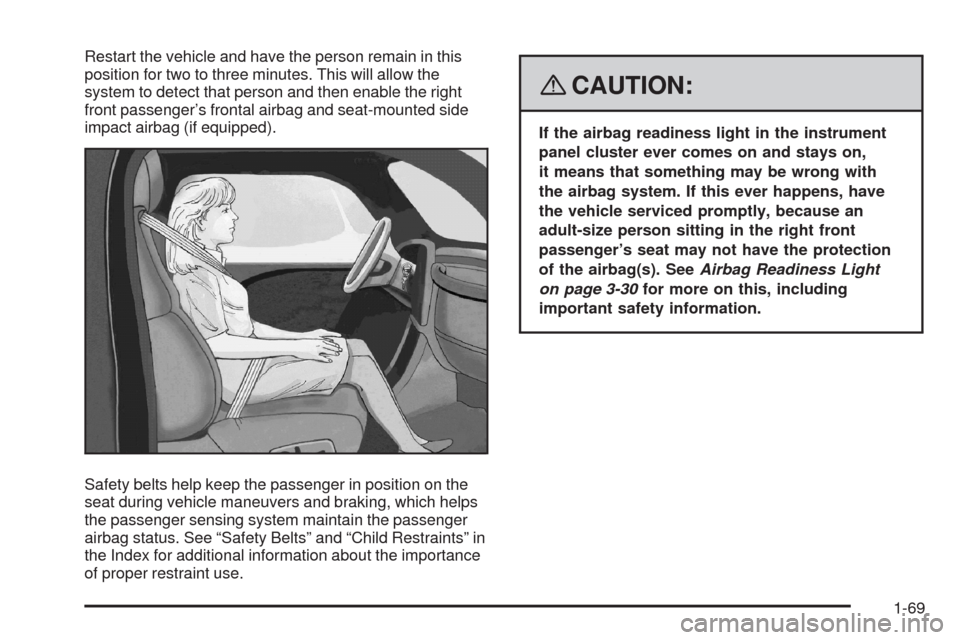
Restart the vehicle and have the person remain in this
position for two to three minutes. This will allow the
system to detect that person and then enable the right
front passenger’s frontal airbag and seat-mounted side
impact airbag (if equipped).
Safety belts help keep the passenger in position on the
seat during vehicle maneuvers and braking, which helps
the passenger sensing system maintain the passenger
airbag status. See “Safety Belts” and “Child Restraints” in
the Index for additional information about the importance
of proper restraint use.
{CAUTION:
If the airbag readiness light in the instrument
panel cluster ever comes on and stays on,
it means that something may be wrong with
the airbag system. If this ever happens, have
the vehicle serviced promptly, because an
adult-size person sitting in the right front
passenger’s seat may not have the protection
of the airbag(s). SeeAirbag Readiness Light
on page 3-30for more on this, including
important safety information.
1-69
Page 91 of 384
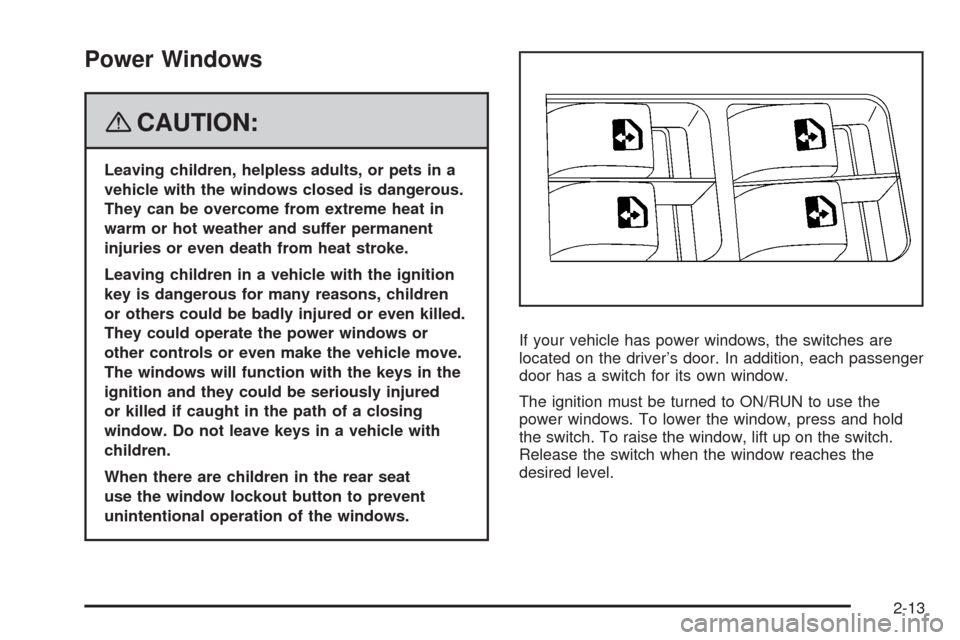
Power Windows
{CAUTION:
Leaving children, helpless adults, or pets in a
vehicle with the windows closed is dangerous.
They can be overcome from extreme heat in
warm or hot weather and suffer permanent
injuries or even death from heat stroke.
Leaving children in a vehicle with the ignition
key is dangerous for many reasons, children
or others could be badly injured or even killed.
They could operate the power windows or
other controls or even make the vehicle move.
The windows will function with the keys in the
ignition and they could be seriously injured
or killed if caught in the path of a closing
window. Do not leave keys in a vehicle with
children.
When there are children in the rear seat
use the window lockout button to prevent
unintentional operation of the windows.If your vehicle has power windows, the switches are
located on the driver’s door. In addition, each passenger
door has a switch for its own window.
The ignition must be turned to ON/RUN to use the
power windows. To lower the window, press and hold
the switch. To raise the window, lift up on the switch.
Release the switch when the window reaches the
desired level.
2-13
Page 146 of 384
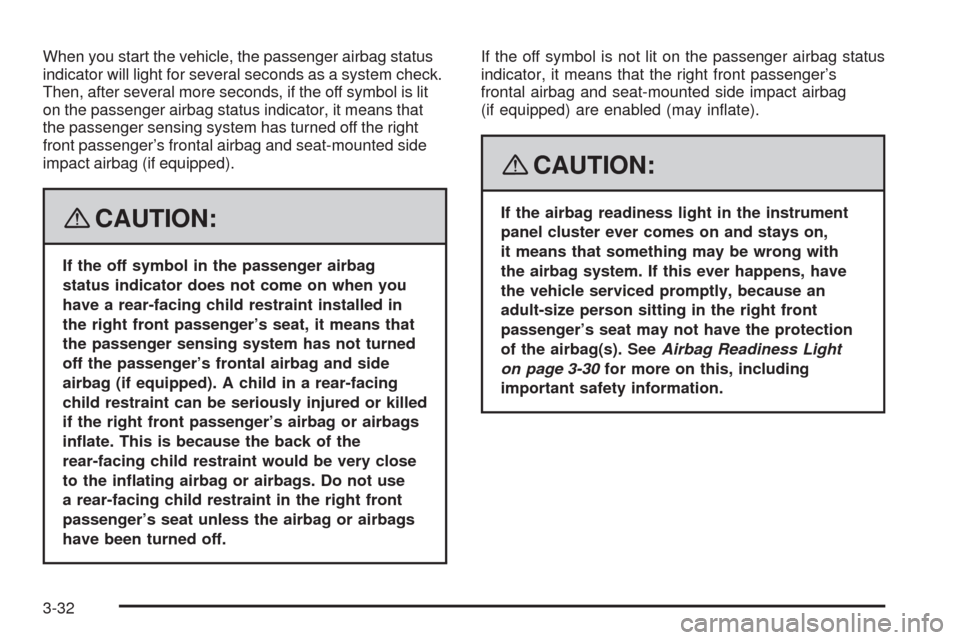
When you start the vehicle, the passenger airbag status
indicator will light for several seconds as a system check.
Then, after several more seconds, if the off symbol is lit
on the passenger airbag status indicator, it means that
the passenger sensing system has turned off the right
front passenger’s frontal airbag and seat-mounted side
impact airbag (if equipped).
{CAUTION:
If the off symbol in the passenger airbag
status indicator does not come on when you
have a rear-facing child restraint installed in
the right front passenger’s seat, it means that
the passenger sensing system has not turned
off the passenger’s frontal airbag and side
airbag (if equipped). A child in a rear-facing
child restraint can be seriously injured or killed
if the right front passenger’s airbag or airbags
in�ate. This is because the back of the
rear-facing child restraint would be very close
to the in�ating airbag or airbags. Do not use
a rear-facing child restraint in the right front
passenger’s seat unless the airbag or airbags
have been turned off.If the off symbol is not lit on the passenger airbag status
indicator, it means that the right front passenger’s
frontal airbag and seat-mounted side impact airbag
(if equipped) are enabled (may inflate).
{CAUTION:
If the airbag readiness light in the instrument
panel cluster ever comes on and stays on,
it means that something may be wrong with
the airbag system. If this ever happens, have
the vehicle serviced promptly, because an
adult-size person sitting in the right front
passenger’s seat may not have the protection
of the airbag(s). SeeAirbag Readiness Light
on page 3-30for more on this, including
important safety information.
3-32
Page 160 of 384
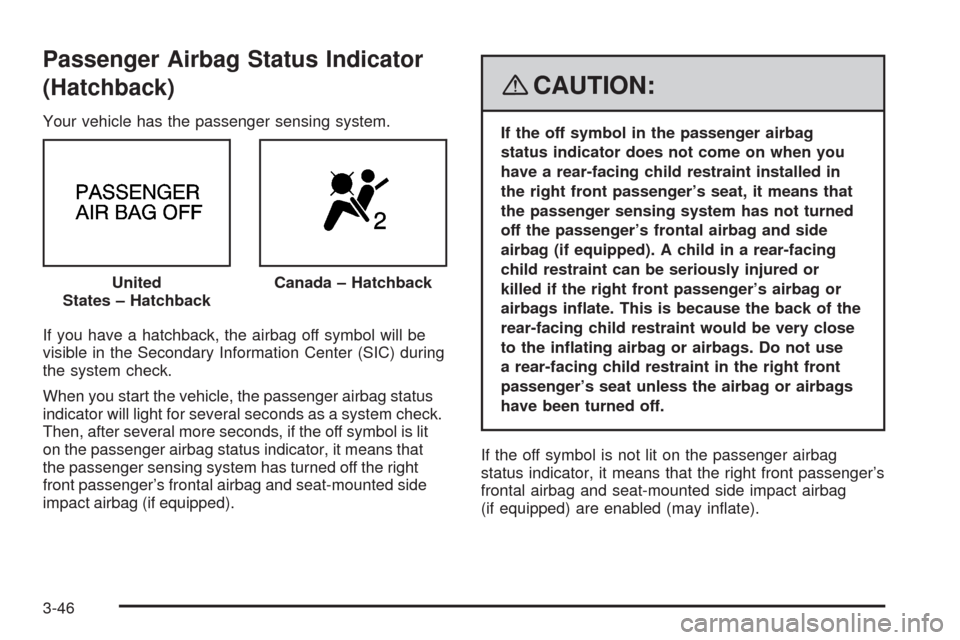
Passenger Airbag Status Indicator
(Hatchback)
Your vehicle has the passenger sensing system.
If you have a hatchback, the airbag off symbol will be
visible in the Secondary Information Center (SIC) during
the system check.
When you start the vehicle, the passenger airbag status
indicator will light for several seconds as a system check.
Then, after several more seconds, if the off symbol is lit
on the passenger airbag status indicator, it means that
the passenger sensing system has turned off the right
front passenger’s frontal airbag and seat-mounted side
impact airbag (if equipped).
{CAUTION:
If the off symbol in the passenger airbag
status indicator does not come on when you
have a rear-facing child restraint installed in
the right front passenger’s seat, it means that
the passenger sensing system has not turned
off the passenger’s frontal airbag and side
airbag (if equipped). A child in a rear-facing
child restraint can be seriously injured or
killed if the right front passenger’s airbag or
airbags in�ate. This is because the back of the
rear-facing child restraint would be very close
to the in�ating airbag or airbags. Do not use
a rear-facing child restraint in the right front
passenger’s seat unless the airbag or airbags
have been turned off.
If the off symbol is not lit on the passenger airbag
status indicator, it means that the right front passenger’s
frontal airbag and seat-mounted side impact airbag
(if equipped) are enabled (may inflate). United
States – Hatchback
Canada – Hatchback
3-46
Page 220 of 384
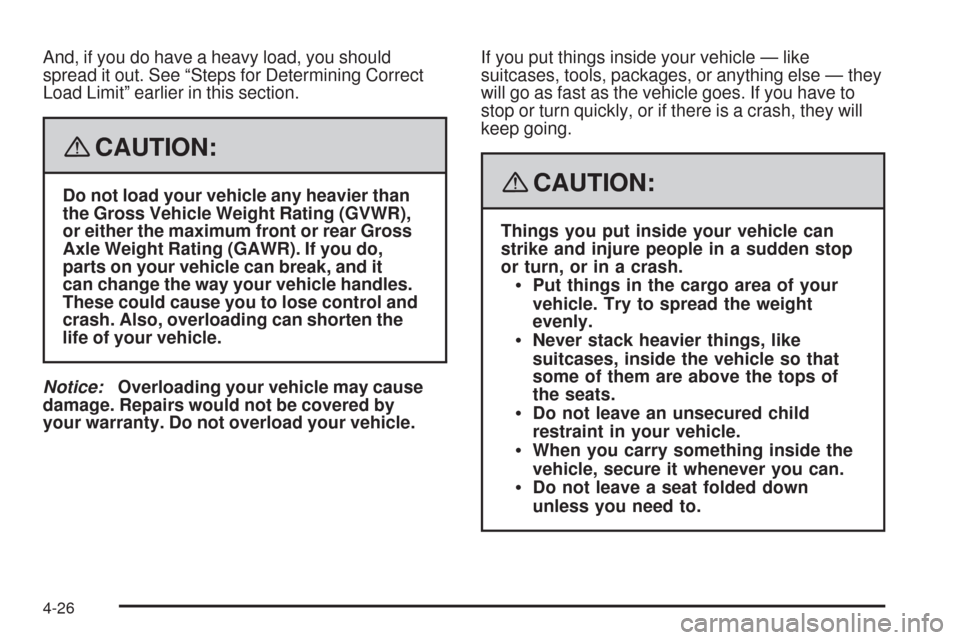
And, if you do have a heavy load, you should
spread it out. See “Steps for Determining Correct
Load Limit” earlier in this section.
{CAUTION:
Do not load your vehicle any heavier than
the Gross Vehicle Weight Rating (GVWR),
or either the maximum front or rear Gross
Axle Weight Rating (GAWR). If you do,
parts on your vehicle can break, and it
can change the way your vehicle handles.
These could cause you to lose control and
crash. Also, overloading can shorten the
life of your vehicle.
Notice:Overloading your vehicle may cause
damage. Repairs would not be covered by
your warranty. Do not overload your vehicle.If you put things inside your vehicle — like
suitcases, tools, packages, or anything else — they
will go as fast as the vehicle goes. If you have to
stop or turn quickly, or if there is a crash, they will
keep going.{CAUTION:
Things you put inside your vehicle can
strike and injure people in a sudden stop
or turn, or in a crash.
Put things in the cargo area of your
vehicle. Try to spread the weight
evenly.
Never stack heavier things, like
suitcases, inside the vehicle so that
some of them are above the tops of
the seats.
Do not leave an unsecured child
restraint in your vehicle.
When you carry something inside the
vehicle, secure it whenever you can.
Do not leave a seat folded down
unless you need to.
4-26
Page 229 of 384
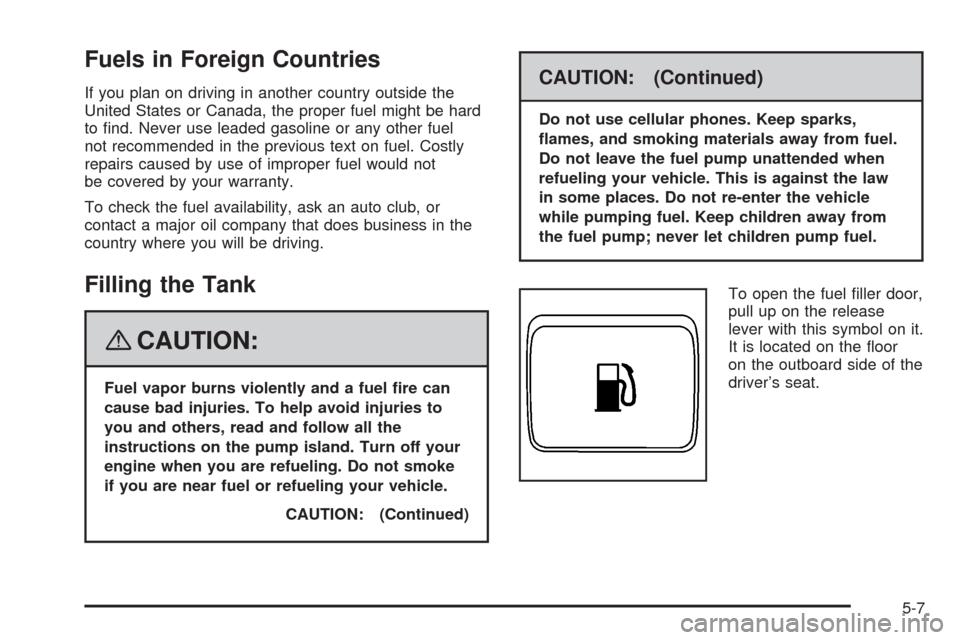
Fuels in Foreign Countries
If you plan on driving in another country outside the
United States or Canada, the proper fuel might be hard
to find. Never use leaded gasoline or any other fuel
not recommended in the previous text on fuel. Costly
repairs caused by use of improper fuel would not
be covered by your warranty.
To check the fuel availability, ask an auto club, or
contact a major oil company that does business in the
country where you will be driving.
Filling the Tank
{CAUTION:
Fuel vapor burns violently and a fuel �re can
cause bad injuries. To help avoid injuries to
you and others, read and follow all the
instructions on the pump island. Turn off your
engine when you are refueling. Do not smoke
if you are near fuel or refueling your vehicle.
CAUTION: (Continued)
CAUTION: (Continued)
Do not use cellular phones. Keep sparks,
�ames, and smoking materials away from fuel.
Do not leave the fuel pump unattended when
refueling your vehicle. This is against the law
in some places. Do not re-enter the vehicle
while pumping fuel. Keep children away from
the fuel pump; never let children pump fuel.
To open the fuel filler door,
pull up on the release
lever with this symbol on it.
It is located on the floor
on the outboard side of the
driver’s seat.
5-7
Page 373 of 384

Check
Engine Light.......................................3-36, 3-49
Checking Things Under the Hood......................5-10
Chemical Paint Spotting...................................5-86
Child Restraints
Child Restraint Systems...............................1-38
Infants and Young Children...........................1-34
Lower Anchors and Tethers for Children..........1-42
Older Children.............................................1-32
Securing a Child Restraint in a
Rear Seat Position...................................1-49
Securing a Child Restraint in the
Right Front Seat Position..........................1-52
Where to Put the Restraint...........................1-40
Cigarette Lighter.............................................3-19
Cleaning
Aluminum Wheels........................................5-85
Exterior Lamps/Lenses.................................5-83
Fabric/Carpet..............................................5-80
Finish Care.................................................5-83
Instrument Panel, Vinyl, and Other
Plastic Surfaces.......................................5-82
Interior.......................................................5-79
Leather......................................................5-81
Tires..........................................................5-85
Underbody Maintenance...............................5-86Cleaning (cont.)
Washing Your Vehicle...................................5-83
Weatherstrips..............................................5-82
Windshield and Wiper Blades........................5-84
Climate Control System...................................3-20
Air Filter, Passenger Compartment.................3-24
Outlet Adjustment........................................3-24
Clock....................................................3-20, 3-44
Clutch, Hydraulic.............................................5-21
Collision Damage Repair..................................7-13
Compact Spare Tire........................................5-78
Control of a Vehicle.......................................... 4-3
Coolant
Engine Temperature Gage
............................3-35
Heater, Engine............................................2-20
Surge Tank Pressure Cap.............................5-25
Cooling System..............................................5-26
Cruise Control................................................3-13
Cruise Control Light................................3-40, 3-53
Cupholder(s)..................................................2-35
Customer Assistance Information
Courtesy Transportation................................7-11
Customer Assistance for Text
Telephone (TTY) Users............................... 7-6
Customer Assistance Offices........................... 7-6
Customer Satisfaction Procedure..................... 7-2
3